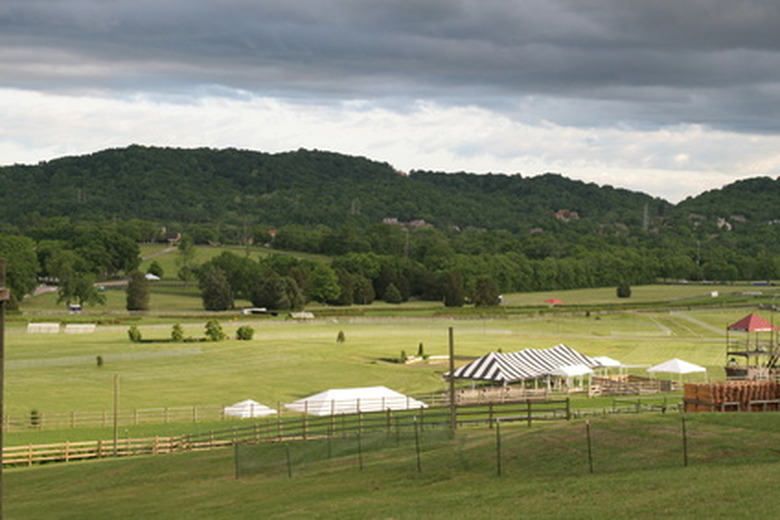How To Grow Grass In Eastern Tennessee
Things Needed
- Herbicide
- Coarse sand
- Compost
- Gardening fork
- Rake
- 2-by-4 lumber
- Level
- Straw
- Fertilizer
Turf grasses are categorized as either warm-season or cool-season grasses. In the United States, the transition zone between the warm and cool zones happens to run through Tennessee. This presents a challenge for the eastern Tennessee gardener: cool-season grasses turn brown in hot summer weather and the warm-season grasses won't survive the winter. Growers at American Lawns suggest planting tall fescue (Festuca arundinacea) in eastern Tennessee. It stands up to high traffic and can even be grown in the shade. Begin preparing the planting area several weeks before planting the grass seed, which should be done from August 20 to September 15.
Step 1
Remove any weeds from the area using an herbicide, such as those that contain glyphosate, according to label instructions. Remove any rocks or other debris in the planting area.
- Turf grasses are categorized as either warm-season or cool-season grasses.
- Growers at American Lawns suggest planting tall fescue (Festuca arundinacea) in eastern Tennessee.
Step 2
Mix 4 to 6 inches of coarse sand and 3 inches of compost into the existing soil.
Step 3
Test the pH of the soil. According to the Tennessee Cooperative Extension, eastern Tennessee soils generally lack sufficient nitrogen for fescue growth. Your local cooperative extension office offers soil testing facilities and the agents can recommend a suitable nitrogen fertilizer, if required by the results of the test. Add these amendments to the soil at the suggested rate.
Step 4
Create a rough grade to direct water away from the home. A 1 to 2 percent slope is generally recommended. Lay a 2-by-4 board on the soil, directed from the house to the drainage area. Place the level on top. Raise the end of the 2-by-4 furthest from the house until level, according to the level bar. Check the distance between the end of the 2-by-4 and the soil. You need this distance to be 2 inches. Add or remove soil to obtain the proper slope. Rake the area smooth, removing any hills and filling in any depressions in the soil.
- Mix 4 to 6 inches of coarse sand and 3 inches of compost into the existing soil.
- Lay a 2-by-4 board on the soil, directed from the house to the drainage area.
Step 5
Water the planting area to a depth of 5 or 6 inches. Wait one week before planting.
Step 6
Sow the seeds at a rate of 5 pounds of grass seed per 1,000 square feet of planting area. Fill the broadcast seeder with half the seed and sow as you walk in a north-south direction. Fill the seeder with the other half of the seed and sow in a east-west direction. Run a rake lightly over the area to mix the seeds into the top layer of soil.
Step 7
Lay down clean straw mulch over the seeds in a single layer so as to not shade the seeds too much. Master Gardeners with the University of Tennessee Cooperative Extension suggest that 100 pounds of straw is sufficient to mulch a 1,000-square-foot planting area. Mulch ensures that the new seeds don't wash away and also protects the young seedlings from extremes in eastern Tennessee temperatures.
- Water the planting area to a depth of 5 or 6 inches.
- Run a rake lightly over the area to mix the seeds into the top layer of soil.
Step 8
Water the new seedbed immediately after planting and water several times a day thereafter. The top 2 inches of soil should remain moist. When the grass reaches 2 inches in height, cut back on how often you water. In eastern Tennessee, 1 to 1 1/2 inches of water per week is generally sufficient. Provide extra water during particularly hot and dry periods.
Step 9
Mow the lawn for the first time when the lawn is 3 inches tall and cut it back to 2 inches. Don't bag the clippings, as tall fescue enjoys the mulch when the clippings are left on the lawn.
- Water the new seedbed immediately after planting and water several times a day thereafter.
- The top 2 inches of soil should remain moist.
Step 10
Fertilize the lawn in mid-March and mid-April with a 1-0-0 formula at a rate of 1/2 pound per 1.000 square feet of planting area. In September and October give the lawn 1 pound of a 2-1-1 formula fertilizer and in mid-November fertilize with 1 pound (per 1,000 square feet) of 1-0-0. Eastern Tennessee soils generally contain enough secondary nutrients but lack the high nitrogen required of tall fescue, so the fall applications of the secondary nutrients is sufficient, according to agriculturists with the University of Tennessee.
